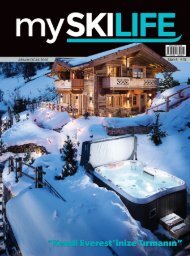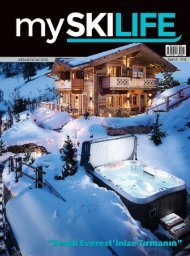You also want an ePaper? Increase the reach of your titles
YUMPU automatically turns print PDFs into web optimized ePapers that Google loves.
Hacıbektaş<br />
İlçeye adını veren Hacı Bektaş-ı Veli,<br />
bugün İran sınırları içerisinde bulunan<br />
Horasan’da 13. yüzyılda dünyaya gelir.<br />
Hacı Bektaş, ilk eğitimini dönemin<br />
ünlü düşünürü Ahmet Yesevi’den<br />
alır.Hacı Bektaş’ın, o yüzyıllarda<br />
Türklerin doğudan batıya göçlerini<br />
izleyerekAnadolu’ya gelişi, Anadolu<br />
Selçuklularının siyasi ve iktisadi<br />
düzenlerinin bozulduğu, yönetimde<br />
bölünmelerin ortaya çıktığı bir döneme<br />
rastlar. Bu dönemde şehir şehir, köy köy<br />
gezerek, Türk birliğinin sağlanması, Türk<br />
gelenek ve göreneklerin İslam inancıyla<br />
birleşmesi için çaba harcayan Hacı<br />
Bektaş, Sulucakarahöyük’te kurduğu<br />
okulda öğrenciler yetiştirdi, Türk dili<br />
ve kültürünün yabancı etkilerden ve<br />
her türlü yozlaşmadan korunması için<br />
çalıştı, içinde Hacı Bektaş Velinin ve<br />
Balım Sultan’ın türbelerinin bulunduğu<br />
3 avlulu külliyede cami, çamaşırhane,<br />
hamam, aş evi, konuk evi ve çeşmeler<br />
yer alır.<br />
Geleneksel Mimari<br />
Kapadokya’da doğal yapı ve çevre koşulları<br />
sonucu oldukça özgün bir konut mimarisi<br />
görülür. Mimari öğeler, doğal konumun<br />
uzantısı gibidir. En kısa ifadesiyle ister in<br />
san eliyle şekillendirilmiş olsun, ister hiçbir<br />
işleme tabi tutulmasın, Kapadokya’da<br />
taş, meskendir. Bu volkanik bölgede taşm<br />
bol, ağacın az olması, halkı taş mimariye<br />
yöneltmiştir. Savunma amaçlı olarak inşa<br />
edilen yeraltı şehirleri en özgün mimari<br />
unsurlarını oluşturur. Jeolojik malzeme<br />
olan tüfün kolayca işlenebilen bir madde<br />
olması nedeniyle dağ, tepe yamaçları, peri<br />
bacaları oyularak, ev biçimine sokulmuştur.<br />
Yamaçlara, kayalara ev yapma geleneği bazı<br />
yörelerde hâlâ devam eder. Eski mağaralar,<br />
kaya evlerinin önemli kısmı bugün narenciye<br />
deposu şaraphane, kiler ya da turistik tesis<br />
(otel, lokanta, bar-disko) olarak kullanılır.<br />
Bugün koruma altına alınan veya turistik tesis<br />
olarak kullanılan kaya oyma evler, modern<br />
mağara görünümündedir. İçerisinde her<br />
türlü donanıma sahip olan yapılardaki odaları<br />
emsallerinden, yöresel mimari ayırır. Ürgüp’te<br />
Esbelli Evi, Ürgüp Evi gibi otel olarak hizmet<br />
veren yapılar, bu mimarinin uluslararası<br />
üne sahip örneklerini oluşturur. En önemli<br />
yapı malzemesi olan taş, tümüyle yöreden<br />
sağlanır. Belli boyutlarda işlenen taşlar,<br />
yapıların revaklı ön yüzlerinde geometrik<br />
bir düzen içinde kullanılarak, devinimli bir<br />
görünüm elde edilir. Yöre ağaçsız olduğu<br />
için ahşap süsleme azdır. Yüklükler perdeyle<br />
örtülür. Tüm kapılar eşiklidir.<br />
Hacibektas<br />
He gave his name to the district<br />
who was born in the 13th century in<br />
today’s Khorasan within Iran borders.<br />
Hacı Bektas received his first education<br />
from the period’s famous thinker Ahmet<br />
Yesevi. He followed the migrations of<br />
the Turks from east to west in that century<br />
and came to Anatolia and it was the<br />
period that the political and economic<br />
orders of Seljuk’s deteriorated and the<br />
division occurred in the authority.<br />
Traditional Architecture<br />
As a result of natural structure and<br />
environmental conditions, a pretty<br />
unique residential architecture is seen in<br />
Cappadocia. Architectural elements are like<br />
an extension of the natural structure. The<br />
dwelling in Cappadocia is stone whether it<br />
is shaped by humans or it is not processed.<br />
In this volcanic region, the abundant of<br />
stones and lack of trees led public to stone<br />
architecture. The underground cities create<br />
the most original architectural elements<br />
which were built for the purpose of defence.<br />
Tuffs were geological substances that could<br />
be processed easily so mountains, hillsides<br />
and fairy chimneys were carved to make<br />
houses. The tradition of building houses<br />
into rocks still continues in some areas. The<br />
ancient caves and most of the rock houses<br />
He endeavoured to ensure the Turkish<br />
union, tried to combine the Turkish<br />
traditions and customs with Islamic faith.<br />
He also trained children in the school<br />
established in Sulucakarahoyuk and<br />
he worked very hard to protect Turkish<br />
language and culture from foreign<br />
effects and corruptions. The tombs of<br />
Haci Bektas and Balim Sultan are in the<br />
social complex with three courtyards.<br />
There is also a church, a laundrette,<br />
a Turkish bath, a meal centre, a guest<br />
house with fountains in the complex.<br />
are used as a citrus reservoir, a winery or a<br />
tourist facility (hotel, restaurant, bar-disco).<br />
Today, rock-hewn houses have modern cave<br />
appearance which are under protection or<br />
used as tourist facilities. Structures like the<br />
rooms with all kinds of equipment separate<br />
from the others by vernacular architecture.<br />
Structures like Esbelli House and Urgup<br />
House constitute internationally renowned<br />
examples which are the structures serving as<br />
hotels. The most important building material<br />
stone is entirely provided from the region.<br />
The stones are processed in certain sizes<br />
which are used on the porches on the frontfaces<br />
of the structures by using geometrical<br />
patterns in order, in this way a view of motion<br />
is obtained. Wooden ornaments are rare<br />
because the region is treeless. All doors have<br />
thresholds.<br />
Derinkuyu Yeraltı Şehri<br />
Nevşehir Niğde karayolu üzerinde<br />
eski adı Melegobia olan Derinkuyu,<br />
Nevşehir’e 29 kilometre uzaklıkta yer<br />
alır. Akarsuyu ve gölü bulunmayan<br />
bu ilçenin içme suyunun, 60-70<br />
metre derinlikteki kuyulardan temin<br />
edilmesi nedeniyle “Derinkuyu” olarak<br />
adlandırılır. İlçede 85 metre derinliğinde<br />
bir yeraltı şehri bulunur. Bu şehir, bir<br />
yeraltı kentinde bulunan bütün özellikleri<br />
barındırır. Yaklaşık otuz bin kişi kapasiteli<br />
yerleşim, barınma, yeme, içme, ibadet<br />
ve savunma ihtiyacını karşılayabilecek<br />
düzeydedir.<br />
Özkonak Yeraltı Şehri<br />
Avanos’a 14 kilometrelik mesafede<br />
yer alan Özkonak Yeraltı Şehri, İdiş<br />
Dağının kuzey yamaçlarına volkanik<br />
granit yapılı tüf tabakalarının oldukça<br />
yoğun bulunduğu yere yapılmıştır.<br />
Geniş alanlara yayılmış olan galeriler,<br />
birbirlerine tünellerle bağlanmıştır.<br />
Kaymaklı ve Derinkuyu Yeraltı<br />
şehirlerinden farklı olarak katlar arası<br />
haberleşmeyi sağlayacak çok dar ve<br />
uzun delikler bulunmaktadır. Yine diğer<br />
yeraltı şehirlerinden farklı olarak sürgü<br />
taşından sonra tünel üzerine (düşmana<br />
kızgın yağ dökülmesi amacıyla) delikler<br />
oyulmuştur.<br />
Şarap üretimi yapılabilen, içinde su<br />
kuyusu ve ahırlar bulunan yeraltı şehri,<br />
8 kattan oluşur. Bazı mekanları hala yöre<br />
halkı tarafından depo, kiler ve ahır olarak<br />
kullanılır.<br />
Derinkuyu Underground City<br />
It’s on Nevsehir-Nigde main road and<br />
it was called Melegobia in the past which<br />
is 29 km away from Nevsehir. This town<br />
does not have any streams and lakes so<br />
the drinking water of this place is supplied<br />
from wells in 60-70 metres depth. That’s<br />
why it is called ‘Derinkuyu’. There is an<br />
underground city at 85 metres<br />
depth in the district. This city reserves all<br />
of the features found in an underground<br />
city. The settlement has about thirty<br />
thousand people capacity and it is<br />
sufficient to meet the needs of housing,<br />
eating, drinking, worship and defence.<br />
Wine production can be done; there are<br />
wells and stables in the underground<br />
city which consists of 8 floors. Some<br />
places are still used as stores, cellars and<br />
stables by the local people. The four<br />
floors of the settlement were unearthed<br />
but it is not known on how much area it<br />
is spread. The supply depots, winery,<br />
kitchen, cellar, store and church can still<br />
be visited.<br />
Ozkonak Underground City<br />
Ozkonak Underground City is 14<br />
kilometres away from Avanos which is<br />
located on the northern slopes of Mount<br />
İdiş where volcanic granite structured<br />
tuff layers are intensive. The galleries<br />
spread over a wide area are connected<br />
to each other through the tunnels.<br />
There are very narrow and long holes to<br />
provide communication between the<br />
floors unlike Kaymakli and Derinkuyu<br />
Underground Cities. Again unlike other<br />
underground cities, holes are carved<br />
over the tunnel (for the purpose of<br />
spilling hot oil over the enemy)<br />
EYLÜL/EKİM 2015<br />
EYLÜL/EKİM 2015<br />
20 SEPTEMBER/OCTOBER 2015 SEPTEMBER/OCTOBER 2015<br />
21











